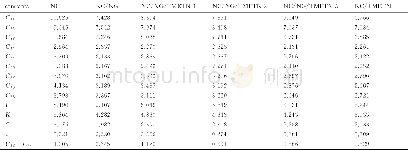《Table 3 Mechanical properties of PLA/PPC/DCP blends with different DCP contents》
 提示:宽带有限、当前游客访问压缩模式
提示:宽带有限、当前游客访问压缩模式
本系列图表出处文件名:随高清版一同展现
《Fully Biodegradable Poly(lactic acid)/Poly(propylene carbonate) Shape Memory Materials with Low Recovery Temperature Based on in situ Compatibilization by Dicumyl Peroxide》
Figure 6 illustrates the stress-strain relationship for the PLA/PPC/DCP blends and Table 3 gives the detailed data.From Fig.6,it is seen that all the samples(with and without DCP)exhibited typical ductile tensile behavior with a yield strength above 45 MPa.When the DCP content was 1 wt%or lower,the elongation at break increased from 40%(PLA/PPC70/30)to 107%(PLA/PPC/DCP 70/30/1),an increase of about 2 times compared with their original binary blends.However,the elongation at break dropped quickly when the content of DCP was above 1 wt%.Combining the gel fraction in Fig.5(f)and the morphology shown in SEM images in Fig.5,the increase of elongation can be attributed to the increase of compatibility of PLA and PPC.The decrease of elongation at break might be caused by excessive cross-linking,leading to a decrease in chain mobility.In general,the cross-linking would enhance the strength.Therefore,the almost unchanged tensile strength for blend with and without DCP was very unusual.It reminds us again that the degradation reaction,accompanying the cross-linking reaction in PLA/PPC/DCP samples,might contribute to the decreased strength when DCP content was higher than 1 wt%.
| 图表编号 | XD0020171600 严禁用于非法目的 |
|---|---|
| 绘制时间 | 2018.06.01 |
| 作者 | Sheng-Xue Qin、Cui-Xiang Yu、Xue-Yang Chen、Hai-Ping Zhou、Li-Fen Zhao |
| 绘制单位 | College of Mechanical and Electric Engineering,College of Materials Science and Engineering, Shandong University of Science and Technology、Qingdao Reinforced Thermoplastic Pipes Engineering Technology Center、College of Mechanical and Electric Engineering, |
| 更多格式 | 高清、无水印(增值服务) |





